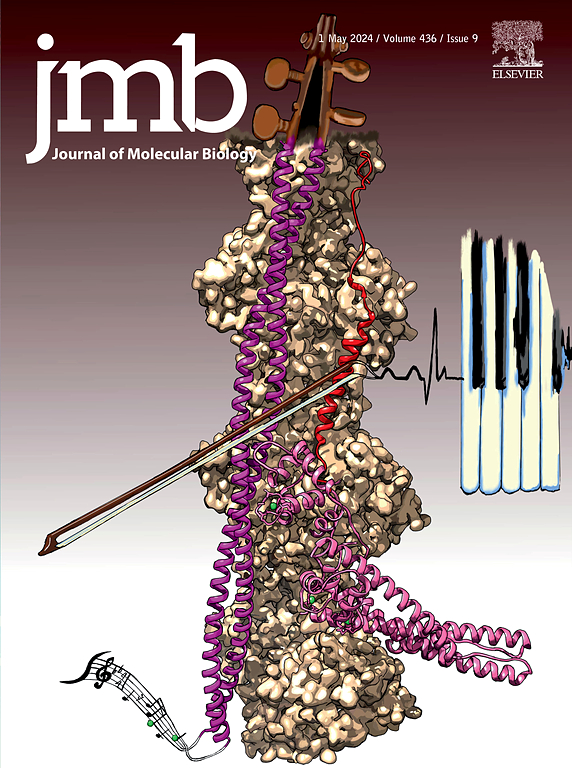Arkadia和Ark2C通过多种E2酶促进底物泛素化。
IF 4.5
2区 生物学
Q1 BIOCHEMISTRY & MOLECULAR BIOLOGY
引用次数: 0
摘要
泛素化是一种关键的翻译后修饰,是细胞活力所必需的。泛素的附着是复杂的,泛素化蛋白的命运取决于附着的泛素链的长度和用于构建链的链接的性质。许多E3连接酶以特定的方式将不同类型的泛素链连接到底物蛋白上,但是E3连接酶如何指定不同类型链的分子细节知之甚少。Arkadia/RNF111是一种大型RING E3连接酶,它用降解泛素链修饰一些底物,而其他底物则用非降解泛素链修饰。在这里,我们利用Arkadia和相关的E3连接酶Ark2C,表征了促进不同键的泛素链组装的RING-E2复合物。我们的结构研究强调了RING-E2界面的保守性,而我们的结合和活性分析揭示了几种不同的E2酶与Ark2C和Arkadia功能相互作用。使用Arkadia,底物泛素化分析揭示了底物修饰能力的差异,E2酶Ubc13和Ube2K需要在后续修饰发生之前添加“引物”泛素分子。我们还表明,与Arkadia紧密结合的底物被更广泛地修饰,并且先前的底物泛素化增强了随后的修饰。虽然需要进一步的研究来了解细胞中如何调节RING-E2配对,但这项研究提高了我们对Arkadia E2招募和链组装的理解,并提供了可能有助于解剖细胞功能的工具。本文章由计算机程序翻译,如有差异,请以英文原文为准。

Arkadia and Ark2C Promote Substrate Ubiquitylation with Multiple E2 Enzymes
Ubiquitylation is a critical post-translational modification that is required for cell vitality. Attachment of ubiquitin is complex, with the fate of ubiquitylated proteins determined by the length of the attached ubiquitin chains and the nature of the linkage used to build the chains. Many E3 ligases attach ubiquitin chains of different types to substrate proteins in a context specific manner, but the molecular details of how E3 ligases specify chains of different types is poorly understood. Arkadia/RNF111 is a large RING E3 ligase that modifies some substrates with degradative ubiquitin chains, while other substrates are modified with non-degradative ubiquitin chains. Here, using Arkadia and the related E3 ligase, Ark2C, we characterize the RING-E2 complexes that promote assembly of ubiquitin chains of distinct linkages. Our structural studies highlight the conserved nature of the RING-E2 interface, while our binding and activity assays reveal several different E2 enzymes that functionally interact with Ark2C and Arkadia. Using Arkadia, substrate ubiquitylation assays reveal differences in the ability for substrates to be modified, with the E2 enzymes Ubc13 and Ube2K requiring addition of a ‘priming’ ubiquitin molecule before subsequent modification can occur. We also show that substrates that bind Arkadia tightly are more extensively modified, and that prior substrate ubiquitylation enhances subsequent modification. While further studies will be required to understand how RING-E2 pairing is modulated in cells, this study advances our understanding of E2 recruitment and chain assembly by Arkadia and provides tools that may help dissect cellular function.
求助全文
通过发布文献求助,成功后即可免费获取论文全文。
去求助
来源期刊

Journal of Molecular Biology
生物-生化与分子生物学
CiteScore
11.30
自引率
1.80%
发文量
412
审稿时长
28 days
期刊介绍:
Journal of Molecular Biology (JMB) provides high quality, comprehensive and broad coverage in all areas of molecular biology. The journal publishes original scientific research papers that provide mechanistic and functional insights and report a significant advance to the field. The journal encourages the submission of multidisciplinary studies that use complementary experimental and computational approaches to address challenging biological questions.
Research areas include but are not limited to: Biomolecular interactions, signaling networks, systems biology; Cell cycle, cell growth, cell differentiation; Cell death, autophagy; Cell signaling and regulation; Chemical biology; Computational biology, in combination with experimental studies; DNA replication, repair, and recombination; Development, regenerative biology, mechanistic and functional studies of stem cells; Epigenetics, chromatin structure and function; Gene expression; Membrane processes, cell surface proteins and cell-cell interactions; Methodological advances, both experimental and theoretical, including databases; Microbiology, virology, and interactions with the host or environment; Microbiota mechanistic and functional studies; Nuclear organization; Post-translational modifications, proteomics; Processing and function of biologically important macromolecules and complexes; Molecular basis of disease; RNA processing, structure and functions of non-coding RNAs, transcription; Sorting, spatiotemporal organization, trafficking; Structural biology; Synthetic biology; Translation, protein folding, chaperones, protein degradation and quality control.
 求助内容:
求助内容: 应助结果提醒方式:
应助结果提醒方式:


